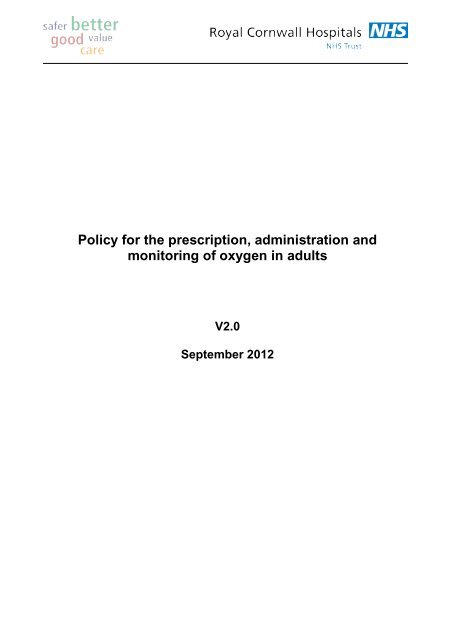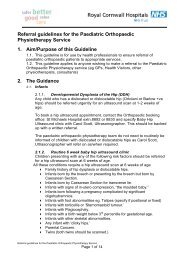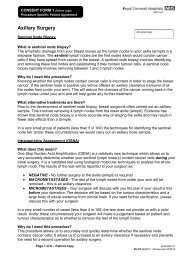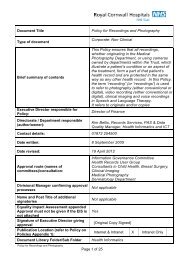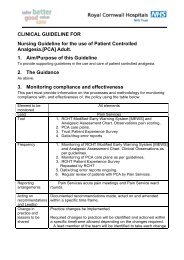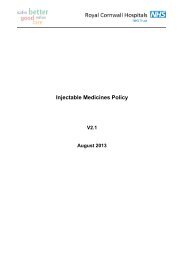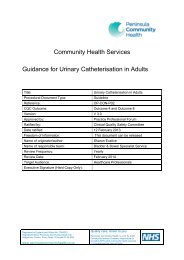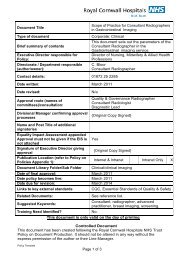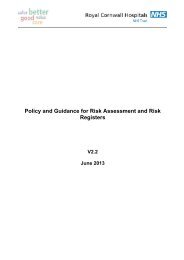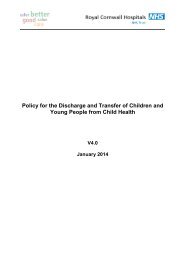Policy for the Prescription, Administration and Monitoring Of Oxygen ...
Policy for the Prescription, Administration and Monitoring Of Oxygen ...
Policy for the Prescription, Administration and Monitoring Of Oxygen ...
- No tags were found...
You also want an ePaper? Increase the reach of your titles
YUMPU automatically turns print PDFs into web optimized ePapers that Google loves.
Table of Contents1. Introduction ...........................................................................................................32. Purpose of this <strong>Policy</strong> ...........................................................................................33. Scope ................................................................................................................. 34. Definitions/Glossary ......................................................................................... ....35. Ownership <strong>and</strong> Responsibilities ............................................................................46. St<strong>and</strong>ards of Practice ............................................................................................46.1. Identifying appropriate target saturations ..................................................46.2. Prescribing oxygen on <strong>the</strong> drug chart ........................................................46.3. Administering oxygen ................................................................................ 46.4. <strong>Monitoring</strong> <strong>and</strong> recording oxygen ...............................................................56.5. Emergency situations .................................................................................56.6. Exclusions ..................................................................................................56.7. Specialist areas ..........................................................................................66.8. Indications ..................................................................................................66.9. Contra-indications ......................................................................................66.10 Cautions .....................................................................................................66.11. Transfer <strong>and</strong> transportation of patients receiving oxygen ..........................76.12. Peri-operative <strong>and</strong> immediately post operatively .......................................76.13. Nebulised <strong>the</strong>rapy <strong>and</strong> oxygen ..................................................................76.14. Normal oxygen saturations ........................................................................76.15. Summary oxygen administration protocol (& weaning protocol) .............. 76.16. Humidification ............................................................................................77. Dissemination <strong>and</strong> implementation ......................................................................98. <strong>Monitoring</strong> compliance <strong>and</strong> effectiveness ............................................................99. Updating <strong>and</strong> review ..........................................................................................1010. Equality <strong>and</strong> diversity .........................................................................................10Appendix a Indications <strong>for</strong> oxygen <strong>the</strong>rapyAppendix b <strong>Oxygen</strong> prescription boxAppendix c Administering oxygen <strong>the</strong>rapyAppendix d <strong>Oxygen</strong> delivery devices <strong>and</strong> equipmentAppendix e Flowchart <strong>for</strong> administration of oxygenAppendix f Personnel who may administer oxygenAppendix g HumidificationAppendix h Health <strong>and</strong> safety<strong>Policy</strong> <strong>for</strong> <strong>the</strong> prescription, administration<strong>and</strong> monitoring of emergency oxygen in adultsPage 2 of 34
1. Introduction1.1. The administration of supplemental oxygen is an essential element of appropriatemanagement <strong>for</strong> a wide range of clinical conditions. Following a NPSA Rapid ResponseReport in 2009 (Ref 1), it is now m<strong>and</strong>atory <strong>for</strong> oxygen to be prescribed in all butemergency situations. Failure to administer oxygen appropriately can potentially result inserious harm tot he patient. The safe implementation of oxygen <strong>the</strong>rapy with appropriatemonitoring is an integral component of <strong>the</strong> healthcare professional's role.1.2. This version supersedes any previous versions of this document.2. Purpose of this <strong>Policy</strong>/ProcedureThe aim of this policy is to ensure that:‣ All patients who require supplementary oxygen <strong>the</strong>rapy receive <strong>the</strong>rapy that isappropriate to <strong>the</strong>ir clinical condition <strong>and</strong> in line with <strong>the</strong> British Thoracic SocietyEmergency <strong>Oxygen</strong> Therapy National Guidelines (Ref 2).‣ <strong>Oxygen</strong> is prescribed according to a target saturation range. The system ofprescribing target saturation aims to achieve specific outcome ra<strong>the</strong>r than specifying<strong>the</strong> oxygen delivery method alone.‣ The multidisciplinary team will administer <strong>and</strong> monitor <strong>the</strong> patient in keeping with <strong>the</strong>target saturation rate.3. Scope1.1. This policy is intended <strong>for</strong> all healthcare professionals initiating, delivering <strong>and</strong>monitoring oxygen4. Definitions / GlossaryABG Arterial blood gasNIV Non-invasive ventilationIPPV Invasive positive pressure ventilationBiPAP Bilevel positive pressure ventilationCPAP Continuous positive pressure ventilationCOPD Chronic obstructive pulmonary diseaseICU Intensive care unitHDU High dependency unitpH pHPaO 2 Arterial oxygen tensionPaCO 2 Arterial carbon dioxide tensionPtCO 2 Transcutaneous carbon dioxideHR Heart rateRR Respiratory rateFi02 Fraction of inspired oxygenSpO2 <strong>Oxygen</strong> saturations measured by pulse oximetry<strong>Policy</strong> <strong>for</strong> <strong>the</strong> prescription, administration<strong>and</strong> monitoring of emergency oxygen in adultsPage 3 of 34
provided <strong>for</strong> those administering oxygen in Appendices c <strong>and</strong> d. Personnel who mayadminister oxygen is shown in Appendix f.6.4. <strong>Monitoring</strong> <strong>and</strong> recording oxygenThe patient's oxygen saturation <strong>and</strong> oxygen delivery system should be recorded on <strong>the</strong>bedside observation chart alongside o<strong>the</strong>r physiological variables. The codes <strong>for</strong> oxygendelivery devices should be recorded on <strong>the</strong> observation charts (MEWS).All patients on oxygen <strong>the</strong>rapy should have regular pulse oximetry measurements. Thefrequency of oximetry measurement will depend on <strong>the</strong> condition being treated <strong>and</strong> <strong>the</strong>stability of <strong>the</strong> patient. Critically ill patients should have <strong>the</strong>ir oxygen saturations monitoredcontinuously. Patients on oxygen should have <strong>the</strong>ir saturations recorded at intervals inline with <strong>the</strong> RCHT minimum observation policy (MEWS).At every drug round nursing staff must ensure that every patient receiving oxygen arewithin <strong>the</strong> documented target saturation range. If not, oxygen <strong>the</strong>rapy should be increasedif <strong>the</strong> saturation is below <strong>the</strong> desired range <strong>and</strong> decreased if <strong>the</strong> saturation is above <strong>the</strong>desired range (<strong>and</strong> eventually discontinued as <strong>the</strong> patient recovers). Nursing staff need toremain with <strong>the</strong> patient until <strong>the</strong> target saturation range is achieved. See Appendix e <strong>for</strong>more details. Medical staff should be in<strong>for</strong>med if <strong>the</strong>re is a significant increase in oxygenrequirement (Appendix e). Patients should be monitored accurately <strong>for</strong> signs ofimprovement or deterioration. Nurses should also monitor skin colour <strong>for</strong> peripheralcyanosis <strong>and</strong> respiratory rate.6.5. Emergency situationsIn an emergency situation an oxygen prescription is not required. <strong>Oxygen</strong> should begiven to <strong>the</strong> patient immediately without a <strong>for</strong>mal prescription or drug order butdocumented later in <strong>the</strong> patient's record.All peri-arrest <strong>and</strong> critically ill patients should be given high flow oxygen (15L/m reservoirmask) whilst awaiting immediate medical review. Patients with COPD <strong>and</strong> o<strong>the</strong>r riskfactors <strong>for</strong> hypercapnia, who develop critical illness, should have <strong>the</strong> same initial targetsaturations as o<strong>the</strong>r critically ill patients pending urgent blood gas results, after which<strong>the</strong>se patients may need controlled oxygen <strong>the</strong>rapy or supported ventilation if <strong>the</strong>re issevere hypoxaemia <strong>and</strong>/or hypercapnia with respiratory acidosis.All patients who have cardiac or respiratory arrest should have high flow oxygen providedalong with basic/advanced life support.A subsequent written record must be made of what oxygen <strong>the</strong>rapy has been given toevery patient alongside <strong>the</strong> recording of all o<strong>the</strong>r emergency treatment.Any qualified nurse/health professional can commence oxygen <strong>the</strong>rapy in an emergencysituation. This will be in line with local policies within relevant clinical areas.6.6. Exclusions‣ Patients admitted to specialist areas with a specialised oxygen prescribing policy (seeSection 6.7).<strong>Policy</strong> <strong>for</strong> <strong>the</strong> prescription, administration<strong>and</strong> monitoring of emergency oxygen in adultsPage 5 of 34
‣ Patients receiving oxygen as part of palliative care, or patients on <strong>the</strong> end of life carepathway (in which case <strong>the</strong> prescriber should choose 'target saturations not indicated'on <strong>the</strong> drug chart/JAC EPMA system).6.7. Specialist areasThis policy is <strong>for</strong> general use within general wards <strong>and</strong> department. Where specific clinicalguidelines are required oxygen administration within specialist areas, <strong>the</strong>y must beapproved via <strong>the</strong> appropriate clinical governance <strong>for</strong>um. They should reflect whereverpossible <strong>the</strong> principles within this policy. Patients transferring from specialist areas mustbe transferred with a prescription <strong>for</strong> <strong>the</strong>ir oxygen <strong>the</strong>rapy utilising target saturation if <strong>the</strong>clinical indication is ongoing. If a patient transfers from an area not utilising <strong>the</strong> targetsaturation system, <strong>the</strong>ir oxygen should be administered as per <strong>the</strong> transferring area'sprescription until <strong>the</strong> patient is reviewed <strong>and</strong> transferred over to <strong>the</strong> target saturationscheme <strong>and</strong> this should occur as soon as possible.6.8. IndicationsThe rationale <strong>for</strong> oxygen <strong>the</strong>rapy is prevention of cellular hypoxia, caused by hypoxaemia(low PaO 2 ) <strong>and</strong> thus prevention of potentially irreversible damage to vital organs.<strong>Oxygen</strong> is not a treatment <strong>for</strong> breathlessness <strong>and</strong> o<strong>the</strong>r caused of tissue hypoxia e.g.anaemia, ischaemia must be addressed. Indications <strong>for</strong> oxygen <strong>the</strong>rapy are listed inAppendix a.6.9 Contra-indicationsThere are no absolute contra-indications to oxygen <strong>the</strong>rapy if indications are judged to bepresent. <strong>the</strong> goal of oxygen <strong>the</strong>rapy is to achieve adequate tissue oxygenation using <strong>the</strong>lowest possible Fi0 2 . Supplemental oxygen should be administered with caution inpatients suffering from paraquat poisoning <strong>and</strong> with acid inhalation or previous belomycinlung injury.6.10 Cautions6.10.1 <strong>Oxygen</strong> induced hypercapniaA subgroup of patients with chronic obstructive pulmonary disease will develop oxygeninduced hypercapnia. O<strong>the</strong>r at risk groups include neuromuscular disorders, morbidobesity <strong>and</strong> chest wall de<strong>for</strong>mities. These high risk patients must be administered withcontrolled oxygen only <strong>and</strong> regular blood gases should be per<strong>for</strong>med to monitor PaCO 2<strong>and</strong> pH if oxygen <strong>the</strong>rapy is increased.6.10.2 O<strong>the</strong>r complications of oxygen <strong>the</strong>rapy‣ Coronary <strong>and</strong> cerebral artery vascoconstriction‣ Pulmonary toxicity‣ Drying of nasal <strong>and</strong> pharyngeal mucosa‣ Skin irritation‣ Fire hazard‣ Pressure sores resulting from <strong>the</strong> delivery device.<strong>Policy</strong> <strong>for</strong> <strong>the</strong> prescription, administration<strong>and</strong> monitoring of emergency oxygen in adultsPage 6 of 34
6.11 Transfer <strong>and</strong> transportation of patients receiving oxygenPatients who are transferred from one area to ano<strong>the</strong>r must have clear documentation of<strong>the</strong>ir ongoing oxygen requirements <strong>and</strong> documentation of <strong>the</strong>ir oxygen saturation. If apatient transfers from one area not utilising <strong>the</strong> target saturation system (see specialistareas above) <strong>the</strong>ir oxygen should be administered as per <strong>the</strong> transferring areasprescription until <strong>the</strong> patient is reviewed <strong>and</strong> transferred to <strong>the</strong> target saturation scheme<strong>and</strong> this should occur as soon as possible.Patients requiring oxygen <strong>the</strong>rapy while being transferred from one area to ano<strong>the</strong>r shouldhave oxygen <strong>the</strong>rapy reviewed prior to leaving <strong>the</strong> clinical area <strong>and</strong> on return by trainednursing staff. Clear instructions must be provided <strong>for</strong> personnel involved in <strong>the</strong> transfer of<strong>the</strong> patient, which must include delivery device <strong>and</strong> flow rate. Please also refer to <strong>the</strong>Portering Services policy on Changing Medical Gas Cylinders.6.12 Peri-operative <strong>and</strong> immediately post operativelyTheatres <strong>and</strong> recovery follow <strong>the</strong> AAGBI guidelines [ref 3,4] with respect to oxygenadministration.However, when patients are transferred back to <strong>the</strong> ward from recovery, oxygen shouldbe prescribed on <strong>the</strong> RCHT drug chart as discussed in Section 6.6.13 Nebulised <strong>the</strong>rapy <strong>and</strong> oxygenWhen nebulised <strong>the</strong>rapy is administered to patients at risk of hypercapnic respiratoryfailure, (see Section 6.10.1) , it should be driven by compressed air. if necessarysupplementary oxygen should be given concurrently by nasal prongs at 1 - 4 litres perminute to maintain an oxygen saturation of 88 - 92% or <strong>the</strong>ir specified target range.All patients requiring 35% or greater oxygen <strong>the</strong>rapy should have <strong>the</strong>ir nebulised <strong>the</strong>rapyby oxygen at a flow rate of >6 litres/minute.6.14 Normal oxygen saturations‣ In adults less than 70 years of age at rest at sea level 96 - 98% when awake.‣ Aged 70 <strong>and</strong> above at rest at sea level greater than 94% when awake.‣ Patients of all ages may have transient dips of saturation to mid-80's% during sleep.6.15 Summary oxygen administration protocol (<strong>and</strong> weaning protocol)ACTIONAll patients requiring oxygen <strong>the</strong>rapy willhave a prescription <strong>for</strong> oxygen <strong>the</strong>rapyrecorded on <strong>the</strong> patients drug prescriptionchart or JAC EPMA system. N.B.Exceptions - see emergency situations.The prescription will incorporate as targetsaturation that will be identified by <strong>the</strong>clinician prescribing <strong>the</strong> oxygen inRATIONALE<strong>Oxygen</strong> should be regarded as a drug <strong>and</strong>should be prescribed. BTS NationalGuidelines (2008). British Formulary(2012).Certain groups of patients require differenttarget ranges <strong>for</strong> <strong>the</strong>ir oxygen saturation,see Appendix a: Tables 1 - 4.<strong>Policy</strong> <strong>for</strong> <strong>the</strong> prescription, administration<strong>and</strong> monitoring of emergency oxygen in adultsPage 7 of 34
accordance with <strong>the</strong> Trust's oxygenguidelineThe prescription will incorporate an initialstarting dose (i.e. delivery device <strong>and</strong> flowrate)The administration of oxygen should berecorded at every drug round e<strong>the</strong>r on <strong>the</strong>drug chart or <strong>the</strong> JAC EPMA systemOnce oxygen is in situ <strong>the</strong> nurse will monitorobservations in line with Trust policy. Allpatients should have <strong>the</strong>ir oxygen saturationobserved <strong>for</strong> at least 5 minutes after startingoxygen <strong>the</strong>rapy.<strong>Oxygen</strong> flow rate should be recordedalongside <strong>the</strong> oxygen saturation on <strong>the</strong>bedside observation chart<strong>Oxygen</strong> saturations must always beinterpreted alongside <strong>the</strong> patient's clinicalstatus incorporating <strong>the</strong> early warning score.if <strong>the</strong> patient falls outside of <strong>the</strong> targetsaturation range <strong>the</strong> oxygen <strong>the</strong>rapy will beadjusted accordingly. <strong>the</strong> saturationsshould be monitored <strong>for</strong> at least 5 minutesafter any increase or decrease in oxygendose to ensure that <strong>the</strong> patient achieves <strong>the</strong>desired saturation range.Saturations higher than target specified‣ Step down oxygen <strong>the</strong>rapy as perguidance <strong>for</strong> delivery‣ Consider discontinuation pf oxygen<strong>the</strong>rapyCertain groups of patients are at risk ofhyperoxaemia, particularly patients withCOPD.To provide <strong>the</strong> nurses with guidance <strong>for</strong> <strong>the</strong>appropriate starting point <strong>for</strong> oxygendelivery system <strong>and</strong> flow rateTo ensure that <strong>the</strong> patient is receivingoxygen <strong>and</strong> that oxygen saturation is within<strong>the</strong> target rangeto identify if oxygen is maintaining <strong>the</strong> targetsaturation or if an increase or decrease inoxygen <strong>the</strong>rapy is requiredTo provide an accurate record <strong>and</strong> allowtrends in oxygen <strong>the</strong>rapy <strong>and</strong> saturationlevels to be identifiedTo maintain <strong>the</strong> saturation in <strong>the</strong> desiredrangeThe patient will require weaning down <strong>for</strong>current oxygen delivery system. SeeAppendix e.The patient's clinical condition may haveimproved negating <strong>the</strong> need <strong>for</strong>supplementary oxygenSaturations lower than target specified‣ Check all elements of oxygen deliverysystem <strong>for</strong> faults or errors.‣ Step up oxygen <strong>the</strong>rapy as perprotocols in Appendix e. Any suddenfall in oxygen saturation should lead toclinical evaluation <strong>and</strong> inmost casesmeasurement of blood gases.‣ Monitor Early Warning Score <strong>and</strong>respiratory rate <strong>for</strong> fur<strong>the</strong>r clinical signsof deterioration‣ Check <strong>and</strong> ensure that <strong>the</strong> patient is<strong>Policy</strong> <strong>for</strong> <strong>the</strong> prescription, administration<strong>and</strong> monitoring of emergency oxygen in adultsPage 8 of 34In most instances a fall in oxygen saturationis due to deterioration of <strong>the</strong> patient,however, equipment faults should bechecked <strong>for</strong>.To assess <strong>the</strong> patient's response to oxygenincrease, <strong>and</strong> ensure that PaCO 2 has notrisen to an unacceptable level, or pHdropped to an unacceptable level <strong>and</strong> toscreen <strong>for</strong> cause of deteriorating oxygenlevelPatient safetyMeasurements of oxygen saturations are
well perfusedSaturation within target specifiedContinue with oxygen <strong>the</strong>rapy, <strong>and</strong> monitorpatient to identify appropriate time <strong>for</strong>stepping down <strong>the</strong>rapy once clinicalcondition allowsA change in delivery device (without anincrease in O 2 <strong>the</strong>rapy) does not requirereview by <strong>the</strong> medial team<strong>Oxygen</strong> delivery methodsThe trust's recommended delivery deviceswill be utilised to ensure a st<strong>and</strong>ardisedapproach to oxygen delivery see Appendixdreliant upon adequate arterial perfusion of<strong>the</strong> patient(The change may be made in stablepatients due to patient preference orcom<strong>for</strong>t)Previous audits have demonstrated widevariations in delivery devices across clinicalareas, potentially increasing <strong>the</strong> risk ofadverse incidents6.16. HumidificationHumidification may be required <strong>for</strong> some patient groups but is not essential, even <strong>for</strong>patients on prolonged <strong>the</strong>rapy. See Appendix g.7. Dissemination <strong>and</strong> ImplementationIt is m<strong>and</strong>atory that all nurses administering oxygen complete <strong>the</strong> Emergency <strong>Oxygen</strong>module on NLMS or attend a training session.All medical students <strong>and</strong> doctors should be taught about <strong>the</strong> oxygen policy. this will befacilitated through regular junior doctor teaching, departmental meetings <strong>and</strong> Gr<strong>and</strong>Rounds.Regular audits are being per<strong>for</strong>med in clinical area as. Additionally <strong>the</strong> Trust will take partin <strong>the</strong> National BTS audit to benchmark out practice against <strong>the</strong> rest of <strong>the</strong> country.The British Thoracic Society has appointed oxygen champions in all Trusts to helpintroduce <strong>the</strong> Guideline. Dr M Wijesinghe <strong>and</strong> Nurse Julie Jephson are <strong>the</strong> oxygenchampions <strong>for</strong> RCHT.8. <strong>Monitoring</strong> compliance <strong>and</strong> effectivenessElement to bemonitoredLeadToolFrequencyReportingarrangementsActing onrecommendations<strong>Oxygen</strong> prescription <strong>and</strong> monitoringDr Meme WijesingheBritish Thoracic Society annual Emergency <strong>Oxygen</strong> AuditAnnualMedical Gases Group, Medication Practice CommitteeDr Meme Wijesinghe<strong>Policy</strong> <strong>for</strong> <strong>the</strong> prescription, administration<strong>and</strong> monitoring of emergency oxygen in adultsPage 9 of 34
<strong>and</strong> Lead(s)Change inpractice <strong>and</strong>lessons to besharedResults will be fed back to Ward Managers/Sisters <strong>and</strong> Matrons.9. Updating <strong>and</strong> ReviewThis policy will be reviewed <strong>and</strong> updated every three years10. Equality <strong>and</strong> DiversityThis document complies with <strong>the</strong> Royal Cornwall Hospitals NHS Trust serviceEquality <strong>and</strong> Diversity statement".10.1 Equality Impact AssessmentThe Initial Equality Impact Assessment Screening Form is at Appendix 2.<strong>Policy</strong> <strong>for</strong> <strong>the</strong> prescription, administration<strong>and</strong> monitoring of emergency oxygen in adultsPage 10 of 34
Appendix 1. Governance In<strong>for</strong>mationDocument Title<strong>Policy</strong> <strong>for</strong> <strong>the</strong> prescription, administration <strong>and</strong>monitoring of oxygen in adultsDate Issued/Approved: 14 th December 2012 2012Date Valid From: 14 th December 2012 2012Date Valid To: 1 st December 2015Directorate / Department responsible(author/owner):Pharmacy DepartmentContact details: 01872 252593Brief summary of contents<strong>Policy</strong> <strong>for</strong> <strong>the</strong> prescription, administration <strong>and</strong>monitoring of emergency oxygen in adultsSuggested Keywords:Target AudienceExecutive Director responsible <strong>for</strong><strong>Policy</strong>:<strong>Oxygen</strong>, reservoir mask, hypercapnic,respiratory, oxygen <strong>the</strong>rapy, oximetry.saturationRCHT PCT CFTMedical DirectorDate revised: November 2012This document replaces (exact title ofprevious version):Approval route (names ofcommittees)/consultation:Emergency <strong>Oxygen</strong> <strong>Policy</strong>Medical Gases GroupMedication Practice CommitteeDivisional Manager confirmingapproval processesName <strong>and</strong> Post Title of additionalsignatoriesSignature of Executive Director givingapprovalPublication Location (refer to <strong>Policy</strong>on Policies – Approvals <strong>and</strong>Ratification):Document Library Folder/Sub FolderLinks to key external st<strong>and</strong>ardsDivisional Manager <strong>for</strong> Diagnostics <strong>and</strong>TherapeuticsNot required{Original Copy Signed}Internet & Intranet Intranet OnlyClinical/ PharmacyCQC Outcome 9 Medicines ManagementNHSLA<strong>Policy</strong> <strong>for</strong> <strong>the</strong> prescription, administration<strong>and</strong> monitoring of emergency oxygen in adultsPage 11 of 34
Related Documents:Training Need Identified?NPSA <strong>Oxygen</strong> safety in hospital RapidResponse Report (NPSA/2009/RRR06)BTS guideline <strong>for</strong> emergency oxygen use inadult patients(2008)YesVersion Control TableDateVersionNoSummary of ChangesChanges Made by(Name <strong>and</strong> Job Title)05/09/09 V1.0 First Issue Johanna Kendall05/11/12 V2.0Complete review - changes made to<strong>for</strong>matting <strong>and</strong> content.Dr M WijesingheAll or part of this document can be released under <strong>the</strong> Freedom of In<strong>for</strong>mationAct 2000This document is to be retained <strong>for</strong> 10 years from <strong>the</strong> date of expiry.This document is only valid on <strong>the</strong> day of printingControlled DocumentThis document has been created following <strong>the</strong> Royal Cornwall Hospitals NHS Trust<strong>Policy</strong> on Document Production. It should not be altered in any way without <strong>the</strong>express permission of <strong>the</strong> author or <strong>the</strong>ir Line Manager.<strong>Policy</strong> <strong>for</strong> <strong>the</strong> prescription, administration<strong>and</strong> monitoring of emergency oxygen in adultsPage 12 of 34
Appendix 2.Initial Equality Impact Assessment Screening ForName of service, strategy, policy or project (hereafter referred to as policy) to beassessed:<strong>Policy</strong> <strong>for</strong> <strong>the</strong> prescription, administration <strong>and</strong> monitoring of emergency oxygen inadultsDirectorate <strong>and</strong> service area:Is this a new or existing Procedure?Name of individual completingTelephone:assessment: Linda Mat<strong>the</strong>ws01872 2525931. <strong>Policy</strong> Aim* To ensure that all activities relating to <strong>the</strong> precription,administration <strong>and</strong> monitoring of emergency oxygen use inadults comply with accepted st<strong>and</strong>ards of good practice.2. <strong>Policy</strong> Objectives* To provide evidence based guidelines on <strong>the</strong> prescription,administration <strong>and</strong> monitoring of emergency oxygen inadults3. <strong>Policy</strong> – intendedOutcomes*4. How will you measure<strong>the</strong> outcome?All activities connected to <strong>the</strong> prescription, administration<strong>and</strong> monitoring of emergency oxygen to adults comply withaccepted st<strong>and</strong>ards of good practice.Periodic clinical audit5. Who is intended tobenefit from <strong>the</strong> <strong>Policy</strong>?6a. Is consultationrequired with <strong>the</strong>work<strong>for</strong>ce, equalitygroups, local interestgroups etc. around thispolicy?b. If yes, have <strong>the</strong>segroups been consulted?c. Please list any groupswho have been consultedabout this procedure.Patients receiving oxygen <strong>the</strong>rapyYesYes via a multidisciplinary working group which <strong>for</strong>mulatedthis policy.<strong>the</strong> Medication Practice Committee, Senior Medical, Nursing<strong>and</strong> Pharmacy staff*Please see Glossary7. The ImpactPlease complete <strong>the</strong> following table using ticks. You should refer to <strong>the</strong> EA guidance notes <strong>for</strong>areas of possible impact <strong>and</strong> also <strong>the</strong> Glossary if needed.• Where you think that <strong>the</strong> policy could have a positive impact on any of <strong>the</strong> equalitygroup(s) like promoting equality <strong>and</strong> equal opportunities or improving relations withinequality groups, tick <strong>the</strong> ‘Positive impact’ box.<strong>Policy</strong> <strong>for</strong> <strong>the</strong> prescription, administration<strong>and</strong> monitoring of emergency oxygen in adultsPage 13 of 34
• Where you think that <strong>the</strong> policy could have a negative impact on any of <strong>the</strong> equalitygroup(s) i.e. it could disadvantage <strong>the</strong>m, tick <strong>the</strong> ‘Negative impact’ box.• Where you think that <strong>the</strong> policy has no impact on any of <strong>the</strong> equality group(s) listed belowi.e. it has no effect currently on equality groups, tick <strong>the</strong> ‘No impact’ box.Equality Positive Negative No Reasons <strong>for</strong> decisionGroupImpact Impact ImpactAgeXThis policy is applied irrespectiveof adult patient ageDisability X this policy is applied to patientsirrespective of any disability.Religion orbeliefX This policy describes activities notrelated to faith <strong>and</strong> beliefGender X This policy describes <strong>the</strong>rapies notaffected by gender.Transgender X This policy describes <strong>the</strong>rapies notaffected by transgender.Pregnancy/MaternityX This policy describes <strong>the</strong>rapies notaffected by pregnancy/maternityRace X This policy describes <strong>the</strong>rapies notaffected by pregnancy/maternitySexualOrientationX This policy describes <strong>the</strong>rapies notaffected by sexual orientationMarriage / CivilPartnershipX This policy describes <strong>the</strong>rapies notaffected by marriage or civilpartnershipYou will need to continue to a full Equality Impact Assessment if <strong>the</strong> following have beenhighlighted:• A negative impact <strong>and</strong>• No consultation (this excludes any policies which have been identified as notrequiring consultation).8. If <strong>the</strong>re is no evidence that <strong>the</strong> policypromotes equality, equal opportunitiesor improved relations - could it beadapted so that it does? How?Full statement of commitment to policy ofequal opportunities is included in <strong>the</strong> policyPlease sign <strong>and</strong> date this <strong>for</strong>m.Keep one copy <strong>and</strong> send a copy to Matron, Equality, Diversity <strong>and</strong> Human Rights, c/oRoyal Cornwall Hospitals NHS Trust, Human Resources Department, Chyvean House,Penventinnie Lane, Truro, Cornwall, TR1 3LJA summary of <strong>the</strong> results will be published on <strong>the</strong> Trust’s web site.Signed ________________________________________Date _________________________________________<strong>Policy</strong> <strong>for</strong> <strong>the</strong> prescription, administration<strong>and</strong> monitoring of emergency oxygen in adultsPage 14 of 34
APPENDIX a. Indications <strong>for</strong> oxygen <strong>the</strong>rapyThe British Thoracic Society divide patients into four different groups depending on <strong>the</strong>irdiagnosis <strong>and</strong> oxygen requirements:1. Critical illness requiring high levels of supplementary oxygen.2. Serious illness requiring moderate levels of supplemental oxygen is <strong>the</strong> patient ishypoxaemic.3. COPD <strong>and</strong> or o<strong>the</strong>r condition requiring controlled low-dose oxygen <strong>the</strong>rapy.4. Conditions <strong>for</strong> which patients should be monitored closely but oxygen <strong>the</strong>rapy is notrequired unless <strong>the</strong> patient is hypoxaemic.The following tables set out how oxygen should be administered <strong>and</strong> <strong>the</strong> grades of evidencesupporting oxygen use in <strong>the</strong>se conditions.Table 1: Critical illnesses requiring high levels of supplemental oxygen‣ The initial oxygen <strong>the</strong>rapy is a reservoir mask 15L/min‣ Once stable, reduce <strong>the</strong> oxygen dose <strong>and</strong> aim <strong>for</strong> target saturation range 94 - 98%‣ If oximetry is unavailable, continue to use reservoir mask until definitive treatment isavailable‣ Patients with COPD <strong>and</strong> o<strong>the</strong>r patients at risk of hypercapnia who develop critical illnessshould have <strong>the</strong> same initial target saturations as o<strong>the</strong>r critically ill patients pending <strong>the</strong>results of blood gas measurements, after which <strong>the</strong>se patients may need controlled oxygen<strong>the</strong>rapy or supported ventilation if <strong>the</strong>re is sever hypoxaemia <strong>and</strong> /or hypercapnia withrespiratory acidosis.Condition Additional comments Grade of recommendationCardiac arrest or resuscitation Use bag-valve mask during active Grade DresuscitationAim <strong>for</strong> maximum possible oxygensaturation until patient is stableShock, sepsis, major trauma, neardrowning,Also give specific treatment <strong>for</strong> <strong>the</strong> Grade Danaphylaxis, major underlying conditionpulmonary haemorrhageMajor head injury Early intubation <strong>and</strong> ventilation if Grade DcomatoseCarbon monoxide poisoning Give as much oxygen as possible using abag-valve mask or reservoir mask. Checkcarboxyhaemoglobin levels.A normal or high oximetry reading shouldbe disregarded because saturationmonitors cannot differentiate betweencarboxyhaemoglobin <strong>and</strong> oxyhaemoglobinowing to <strong>the</strong>ir similar absorbencies. <strong>the</strong>blood gas PaO2 will also be normal in<strong>the</strong>se cases (despite <strong>the</strong> presence oftissue hypoxia)Grade C<strong>Policy</strong> <strong>for</strong> <strong>the</strong> prescription, administration<strong>and</strong> monitoring of emergency oxygen in adultsPage 15 of 34
Table 2: Serious illnesses requiring moderate levels of supplemental oxygenif <strong>the</strong> patient is hypoxaemicThe initial oxygen <strong>the</strong>rapy is a nasal cannulae at 2 - 6 1/min (preferably) or simple face mask at 5- 10 l/min unless stated o<strong>the</strong>rwise.<strong>for</strong> patients not at risk of hypercapnic respiratory failure who have saturations
Deterioration of lung fibrosisor o<strong>the</strong>r intersistitial lungdiseaseSevere anaemiasickle cell crisishypoxaemic. Most patientswith pneumothorax are nothypoxaemic <strong>and</strong> do notrequire oxygen <strong>the</strong>rapy.Use a reservoir mask at 10 -15 l/min if admitted <strong>for</strong>observation. aim at 100%saturation) oxygenaccelerates clearance ofpneumothorax is drainage isnot requiredReservoir mask at 10 - 15l/min if initial SpO2
Table 3: COPD <strong>and</strong> o<strong>the</strong>r conditions requiring controlled or low-dose oxygen <strong>the</strong>rapy‣ Prior to availability of blood gases, use 28% Venturi mask at 4 l/min <strong>and</strong> aim <strong>for</strong> an oxygensaturation of 88 - 92% <strong>for</strong> patients with risk factors <strong>for</strong> hypercapnia but no prior history ofrespiratory acidosis.‣ Adjust target range to 94 - 98% if <strong>the</strong> PaCO 2 is normal (unless <strong>the</strong>re is a history ofprevious NIV or IPPV) <strong>and</strong> recheck blood gases after 30 - 60 minutes.‣ Aim at a pre-specified saturation range (from alert card) in patients with a history ofprevious respiratory acidosis. These patients may have <strong>the</strong>ir own venture mask. In <strong>the</strong>absence of an oxygen alert card but with a history of previous respiratory failure (use NIVor IPPV), treatment should be commenced using a 28% oxygen mask at 4 l/min in prehospitalcare of a 24% venturi mask at 2 - 4 l/min in hospital settings with an initial targetsaturation of 88 - 92% pending urgent blood gas results.‣ If <strong>the</strong> saturation remains below 88% in pre-hospital care despite a 28% venture mask,change to nasal cannulae at 2 - 6 l/min or a sample mask at 5 l/min with a targetsaturation of 88 - 92%. All at risk patients with alert cards, previous NIV or IPPV or withsaturation 50 years who are long-term smokers with ahistory of chronic breathlessness on minor exertion, such as walking on level ground, <strong>and</strong>no o<strong>the</strong>r known cause of breathlessness should be treated as if having COPD <strong>for</strong> <strong>the</strong>purposes of this guideline. Patients with COPD may also use terms such as chronicbronchitis <strong>and</strong> emphysema to describe <strong>the</strong>ir condition but may sometimes mistakenly use'asthma'. FEV 1 should be measured on arrival in hospital if possible <strong>and</strong> should bemeasured at least once be<strong>for</strong>e discharge from hospital in all cases of suspected COPD.‣ Patients with a significant likelihood of severe COPD or o<strong>the</strong>r illness that may causehypercapnic respiratory failure should be triaged as very urgent <strong>and</strong> blood gases shouldbe measured on arrival at hospital.‣ Blood gases should be re-checked after 30 - 60 min (or if <strong>the</strong>re is clinical deterioration)even if <strong>the</strong> initial PaCO 2 measurement was normal.‣ If <strong>the</strong> PaCO 2 is raised by pH is ≤ 7.35 ([ H - ] ≤ 45 nmol/l), <strong>the</strong> patient has probably gotlong-st<strong>and</strong>ing hypercapnia; maintain target range of 88 - 92 % <strong>for</strong> <strong>the</strong>se patients. Bloodgases should be repeated at 30 - 60 min to check <strong>for</strong> rising PaCO 2 or falling pH.‣ If <strong>the</strong> patient is hypercapnic ( PaCO 2 >6 kPa or 45 mm Hg) <strong>and</strong> acidotic (pH
CF (cystic fibrosis); COPD (chronic obstructive pulmonary disease); CPAP (continuouspositive airway pressure) IPPV (intermittent positive pressure ventilation); PaCO 2 (arterialcarbon dioxide tension): SpO 2 (arterial oxygen saturation measure by pulse oximetry.Condition Additional Comments Grade of RecommendationCOPDExacerbation of CFChronic NeuromuscularDisordersChest Wall DisordersMorbid ObesityMay need lower range ifacidotic or if known to bevery sensitive to oxygen<strong>the</strong>rapy. Ideally use alertcards to guide treatmentbased on previous blood gasresults. Increase flow by50% if respiratory rate is >30(see recommendation 32)Admit to regional CF centreif possible, if not, discusswith regional centre ormanage according toprotocol agreed withregional CF centre. Ideallyuse alert cards to guide<strong>the</strong>rapy. Increase flow by50% is respiratory rate is>30 (see recommendation32)May require ventilatorsupport. Risk hypercapnicrespiratory failureFor acute neuromusculardisorders <strong>and</strong> subacuteconditions such as GuillainVarre syndrome (see table4)Grade CGrade DGrade DGrade DGrade D<strong>Policy</strong> <strong>for</strong> <strong>the</strong> prescription, administration<strong>and</strong> monitoring of emergency oxygen in adultsPage 19 of 34
Table 4. Conditions <strong>for</strong> which patients should be monitored closely butoxygen <strong>the</strong>rapy is not required unless <strong>the</strong> patient is hypoxaemic‣ If hypoxaemic, <strong>the</strong> initial oxygen <strong>the</strong>rapy is nasal cannulae at 2–6 l/min or simple facemask at 5–10 l/min unless saturation is ,85% (use reservoir mask) or if at risk fromhypercapnia (see below).‣ The recommended initial target saturation range, unless stated o<strong>the</strong>rwise, is 94–98%.‣ If oximetry is not available, give oxygen as above until oximetry or blood gas results areavailable.‣ If patients have COPD or o<strong>the</strong>r risk factors <strong>for</strong> hypercapnic respiratory failure, aim at asaturation of 88–92% pending blood gas results but adjust to 94–98% if <strong>the</strong> PaCO2 isnormal (unless <strong>the</strong>re is a history of respiratory failure requiring NIV or IPPV) <strong>and</strong> recheckblood gases after 30–60 min.Condition Additional comments Grade ofrecommendationMyocardial infarction <strong>and</strong>acutecoronary syndromesMost patients with acute coronaryartery syndromes are nothypoxaemic <strong>and</strong> <strong>the</strong> benefits/harmsof oxygen <strong>the</strong>rapy are unknown insuch casesGrade DStroke Most stroke patients are nothypoxaemic. <strong>Oxygen</strong> <strong>the</strong>rapy maybe harmful <strong>for</strong> non-hypoxaemicpatients with mild to moderatestrokesPregnancy <strong>and</strong> obstetricemergencies<strong>Oxygen</strong> <strong>the</strong>rapy may be harmful to<strong>the</strong> foetus if <strong>the</strong> mo<strong>the</strong>r is nothypoxaemicGrade BGrades A–DHyperventilation ordysfunctionalbreathingExclude organic illness. Patientswith pure hyperventilation due toanxiety or panic attacks are unlikelyto require oxygen <strong>the</strong>rapy.Rebreathing from a paper bag maycause hypoxaemia <strong>and</strong> is notrecommendedGrade CMost poisonings <strong>and</strong> drugoverdoses (see table 1 <strong>for</strong>carbon monoxidepoisoning)Hypoxaemia is more likely withrespiratory depressant drugs, giveantidote if available (e.g. naloxone<strong>for</strong> opiate poisoning).Check blood gases to excludehypercapnia if a respiratorydepressantdrug has been taken. Avoid highblood oxygen levels in cases of<strong>Policy</strong> <strong>for</strong> <strong>the</strong> prescription, administration<strong>and</strong> monitoring of emergency oxygen in adultsPage 20 of 34Grade D
Poisoning with paraquat orbleomycinMetabolic <strong>and</strong> renaldisordersAcute <strong>and</strong> subacuteneurological<strong>and</strong> muscular conditionsproducing muscleweaknessacidaspiration as <strong>the</strong>re is <strong>the</strong>oreticalevidence that oxygen may beharmfulin this conditionMonitor all potentially serious casesof poisoning in a level 2 orlevel 3 environment (highdependency unit or ICU)Patients with paraquat poisoning orbleomycin lung injury may beharmed by supplemental oxygen.Avoid oxygen unless <strong>the</strong> patient ishypoxaemicTarget saturation is 88–92%Most do not need oxygen(tachypnoea may be due toacidosis in <strong>the</strong>sepatients)These patients may requireventilatory support <strong>and</strong> <strong>the</strong>y needcarefulmonitoring which includesspirometry. If <strong>the</strong> patient’s oxygenlevel fallsbelow <strong>the</strong> target saturation, <strong>the</strong>yneed urgent blood gasmeasurements<strong>and</strong> are likely to need ventilatorysupportGrade CGrade DGrade C<strong>Policy</strong> <strong>for</strong> <strong>the</strong> prescription, administration<strong>and</strong> monitoring of emergency oxygen in adultsPage 21 of 34
Appendix b. <strong>Oxygen</strong> prescription box<strong>Policy</strong> <strong>for</strong> <strong>the</strong> prescription, administration<strong>and</strong> monitoring of emergency oxygen in adultsPage 22 of 34
Appendix c. Administering oxygen <strong>the</strong>rapyACTIONRATIONALE1 Ensure airway is patent To promote effective oxygenation2 The type of delivery device used willdepend on <strong>the</strong> needs <strong>and</strong> com<strong>for</strong>t of<strong>the</strong> patient. Most stable patientsprefer nasal cannulae to masks.3 Ensure oxygen is prescribed on <strong>the</strong>prescription chart.The exception to this action wouldbe in an emergency situation where<strong>the</strong> resuscitation guideline should befollowed.4 Ensure that <strong>the</strong> flow rate or dose ofoxygen is clearly stated5 In<strong>for</strong>m patient or relative/carer of <strong>the</strong>combustibility of oxygen6 Show <strong>and</strong> explain <strong>the</strong> oxygendelivery system to <strong>the</strong> patient7 Assemble <strong>the</strong> oxygen deliverysystem carefully8 Attach oxygen delivery system tooxygen source9 Attach oxygen delivery system topatient in accordance withmanufacturers instructions10 Turn on flow rate in accordance withmanufacturers instructions <strong>and</strong>prescription11 Ensure patient has ei<strong>the</strong>r a drink ora mouthwash within reach12 Clean oxygen mask regular withgeneral purpose detergent <strong>and</strong> drythoroughly. For single patientdevices discard after use.To provide accurate oxygendeliveryTo ensure a complete record ismaintained.In accordance with <strong>the</strong>administration of medicinespolicy<strong>Oxygen</strong> supports combustion,<strong>the</strong>re<strong>for</strong>e <strong>the</strong>re is always adanger of fire when oxygen isbeing usedTo obtain consent <strong>and</strong>cooperationTo ensure oxygen is being givenas prescribedTo ensure oxygen supply isreadyTo facilitate oxygen delivery topatientTo administer correct % ofoxygenTo prevent drying of <strong>the</strong> oralmucosaTo minimise infection risk<strong>Policy</strong> <strong>for</strong> <strong>the</strong> prescription, administration<strong>and</strong> monitoring of emergency oxygen in adultsPage 23 of 34
Appendix d. <strong>Oxygen</strong> delivery devices <strong>and</strong> equipmentNasal CannualeDESCRIPTIONNasal cannulae consist of a pair of tubes about 2cm long each projecting into <strong>the</strong> nostril<strong>and</strong> stemming from a tube which passes over <strong>the</strong> ears <strong>and</strong> which is thus self-retainingPURPOSECannulae are preferred to masks by most patients. They have <strong>the</strong> advantage of notinterfering with feeding <strong>and</strong> are more convenient as masks during coughing <strong>and</strong> feeding.They are a variable per<strong>for</strong>mance device <strong>and</strong> deliver a flow rate ra<strong>the</strong>r than a percentage ofoxygen.1.2.3.4.ACTION(When using nasal cannula).Position <strong>the</strong> tips of <strong>the</strong>cannula in <strong>the</strong> patient's noseso that <strong>the</strong> tips do not extendmore than 1.5cm into <strong>the</strong>nose.Place tubing over <strong>the</strong> ears <strong>and</strong>under <strong>the</strong> chin as describedabove. Educate patient reprevention of pressure areason <strong>the</strong> back of <strong>the</strong> ear.Adjust flow rate, usually 2-4L/min but may vary from 1-6L/min in some circumstances.If <strong>the</strong> patient is requiring anemollient <strong>for</strong> <strong>the</strong> treatment ofdry skin secondary to oxygen<strong>the</strong>rapy, a water basedproduct should be used.suitable products include aquagel <strong>and</strong> aqueous cream.RATIONALEOverlong tubing is uncom<strong>for</strong>table, whichmay make <strong>the</strong> patient reject <strong>the</strong>procedure. Sore nasal mucosa can resultfrom pressure of friction tubing that is toolong.To allow optimum com<strong>for</strong>t <strong>for</strong> <strong>the</strong> patient.To prevent pressure soresSet <strong>the</strong> flow rate to achieve <strong>the</strong> desiredtarget oxygen saturation.Paraffin based products should not beused in any circumstances as <strong>the</strong>y areflammable with oxygen.<strong>Policy</strong> <strong>for</strong> <strong>the</strong> prescription, administration<strong>and</strong> monitoring of emergency oxygen in adultsPage 24 of 34
Venturi MasksDESCRIPTIONA mask incorporating a device to enable a fixed concentration of oxygen to be deliveredindependent ofpatient factors or fit to <strong>the</strong> face or flow rate. <strong>Oxygen</strong> is <strong>for</strong>ced out through a small hole causing aVenturi effect which enables air to mix with oxygen.PURPOSEThis is a fixed per<strong>for</strong>mance oxygen mask designed to deliver a specified oxygen concentrationregardless of breathing rate or tidal volume.ACTIONRATIONALE1 (When using Venturi mask)Connect <strong>the</strong> mask to <strong>the</strong> appropriateVenturi barrel attached firmly into <strong>the</strong>mask inlet.To ensure that patient receives <strong>the</strong>correct concentration of oxygen2 Fasten oxygen tubing securely. Correctly secured tubing is com<strong>for</strong>table<strong>and</strong> prevents displacement ofmask/cannulae3 Assess <strong>the</strong> patient’s condition <strong>and</strong>functioning of equipment at regularintervals according to care plan.To ensure patient’s safety <strong>and</strong> thatoxygen is being administered asprescribed.4 Adjust flow rate. The minimum flowrate is indicated on <strong>the</strong> mask orpacket. The flow should be doubled if<strong>the</strong> patient has a respiratory rateabove 30 per minute.Higher flows are required <strong>for</strong> patients withrapid respiration <strong>and</strong> high inspiratory flowrates. This does not affect <strong>the</strong>concentration of oxygen but allows <strong>the</strong>gas flow rate to match <strong>the</strong> patient’sbreathing pattern.5If <strong>the</strong> patient is requiring an emollient<strong>for</strong> <strong>the</strong> treatment of dry skinsecondary to oxygen <strong>the</strong>rapy a waterbased product should be used.Suitable products include aqua gel<strong>and</strong> aqueous cream.Paraffin based products should not beused in any circumstance as <strong>the</strong>y areflammable with oxygen<strong>Policy</strong> <strong>for</strong> <strong>the</strong> prescription, administration<strong>and</strong> monitoring of emergency oxygen in adultsPage 25 of 34
Simple face maskDESCRIPTIONMask has a soft plastic face piece, vent holes are provided to allow air to escape. Maximum50%-60% at15l/min flow.PURPOSEThis is a variable per<strong>for</strong>mance device. The oxygen delivered will be influenced by <strong>the</strong> oxygenflow rate <strong>and</strong> <strong>the</strong> patient’s tidal volume <strong>and</strong> breathing rate. They should not be used in patientswho are at risk of hypercapnic respiratory failure.ACTIONRATIONALE1 (If using simple face mask) Gentlyplace mask over <strong>the</strong> patient’s face,position <strong>the</strong> strap behind <strong>the</strong> head or<strong>the</strong> loops over <strong>the</strong> ears <strong>the</strong>n carefullypull both ends through <strong>the</strong> front of <strong>the</strong>mask until secure.Ensure a com<strong>for</strong>table fit <strong>and</strong> delivery ofprescribed oxygen is maintained.2 Check that strap is not across ears<strong>and</strong> if necessary insert paddingbetween <strong>the</strong> strap <strong>and</strong> head.To prevent irritation.3 Adjust <strong>the</strong> oxygen flow rate. Mustnever be below 5L/minTo ensure patient’s safety <strong>and</strong> that oxygen isbeing administered as prescribed.4 To ensure patient’s safety <strong>and</strong> thatoxygen is being administered asprescribed.Set <strong>the</strong> flow rate to achieve <strong>the</strong> desired targetoxygen saturation.5If <strong>the</strong> patient is requiring anemollient <strong>for</strong> <strong>the</strong> treatment of dryskin secondaryto oxygen <strong>the</strong>rapy a water basedproduct should be used. Suitableproductsinclude aqua gel <strong>and</strong> aqueous creamParaffin based productsshould not be used in anycircumstance as <strong>the</strong>y areflammable with oxygen<strong>Policy</strong> <strong>for</strong> <strong>the</strong> prescription, administration<strong>and</strong> monitoring of emergency oxygen in adultsPage 26 of 34
Reservoir (non-rebrea<strong>the</strong>) maskDESCRIPTIONMask has a soft plastic face piece with flap-valve exhalation ports which may be removed <strong>for</strong>emergency air-intake. There is also a one-way valve between <strong>the</strong> face mask <strong>and</strong> reservoir bag.PURPOSEIn non re-breathing systems <strong>the</strong> oxygen may be stored in <strong>the</strong> reservoir bag during exhalation bymeans of a one-way valve. High concentrations of oxygen 80-90% can be achieved at relativelylow flow rates.They should not be used <strong>for</strong> C02 retaining patients except in life- threatening emergenciessuch as cardiac arrest or major trauma.ACTION1 (Non Rebrea<strong>the</strong> Reservoir Mask)Ensure <strong>the</strong> reservoir bag is inflatedbe<strong>for</strong>e placing mask on patient, thiscan be maintained by using 10-15litres of oxygen per min.2 Adjust <strong>the</strong> oxygen flow to <strong>the</strong>prescribed rate.RATIONALETo ensure <strong>the</strong> optimal flow of oxygen to <strong>the</strong>patient.Inadequate flow rates may result inadministration of inadequate oxygenconcentration to <strong>the</strong> patient or asphyxiation3 If <strong>the</strong> patient is requiring an emollient<strong>for</strong> <strong>the</strong> treatment of dry skinsecondary to oxygen <strong>the</strong>rapy a waterbased product should be used.Suitable products include aqua gel<strong>and</strong> aqueous creamParaffin based products should not be used inany circumstance as <strong>the</strong>y are flammable withoxygen<strong>Policy</strong> <strong>for</strong> <strong>the</strong> prescription, administration<strong>and</strong> monitoring of emergency oxygen in adultsPage 27 of 34
Tracheostomy maskDESCRIPTIONMask designed <strong>for</strong> “neck breathing patients”. Fits com<strong>for</strong>table over tracheostomy or tracheotomy.Exhalation port on front of mask. This is a variable per<strong>for</strong>mance device.PURPOSEThis is a variable per<strong>for</strong>mance device <strong>for</strong> patients with a tracheostomy or tracheotomy. Theoxygen delivered will be influenced by <strong>the</strong> oxygen flow rate <strong>and</strong> <strong>the</strong> patient’s tidal volume <strong>and</strong>breathing rate.ACTION1 Gently place mask over <strong>the</strong> patient’sairway, position <strong>the</strong> strap behind <strong>the</strong>head <strong>the</strong>n carefully pull both endsthrough <strong>the</strong> front of <strong>the</strong> mask untilsecure.2 Adjust <strong>the</strong> oxygen flow rate toachieve <strong>the</strong> desired target saturationrange. Start at 4 l/min <strong>and</strong> adjust <strong>the</strong>flow up or down as necessary toachieve <strong>the</strong> desired oxygensaturation range.RATIONALEEnsure a com<strong>for</strong>table fit <strong>and</strong> delivery ofprescribed oxygen is maintained.To ensure that <strong>the</strong> correct amount ofoxygen is given to keep <strong>the</strong> patient in <strong>the</strong>target range.3 For any prolonged period ofoxygen treatment via atracheostomy mask humidificationshould be considered ei<strong>the</strong>r via acold or heated system.4 If <strong>the</strong> patient is requiring anemollient <strong>for</strong> <strong>the</strong> treatment of dryskin secondary to oxygen <strong>the</strong>rapy awater based product should beused. Suitable products includeaqua gel <strong>and</strong> aqueous creamParaffin based products should not be usedin any circumstance as <strong>the</strong>y are flammablewith oxygen<strong>Policy</strong> <strong>for</strong> <strong>the</strong> prescription, administration<strong>and</strong> monitoring of emergency oxygen in adultsPage 28 of 34
<strong>Oxygen</strong> flow meterDESCRIPTIONDevice to allow <strong>the</strong> patient to receive an accurate flow of oxygenPURPOSETo ensure <strong>the</strong> patient receives <strong>the</strong> correct amount of oxygenAction1 Attach <strong>the</strong> oxygen tubing to <strong>the</strong>nozzle on <strong>the</strong> flow meter.RationaleTo ensure that <strong>the</strong> patient receives<strong>the</strong> correct amount of oxygen.2 Turn <strong>the</strong> finger-valve to obtain <strong>the</strong>desired flow rate. The CENTRE of <strong>the</strong>ball shows <strong>the</strong> correct flow rate.<strong>Policy</strong> <strong>for</strong> <strong>the</strong> prescription, administration<strong>and</strong> monitoring of emergency oxygen in adultsPage 29 of 34
Appendix e: Flowchart <strong>for</strong> <strong>Oxygen</strong> <strong>Administration</strong>Venturi 24% 2 - 4 L/minNasal Cannulae 1 L/mBLUEVenturi 28% 4-6 L/MinNasal Cannulae 2 L/mWHITEIMPORTANTA TWO STEP INCREASEABOVE THE RED LINE =MEDICAL REVIEWVenturi 35% 8-10 L/MinNasal Cannulae 4 l/mYELLOWVenturi 40% at 10 - 12 L/MinREDOr simple face mask at 5 - 6 L/MinIMPORTANTA ONE STEP INCREASEABOVE THE RED LINE =MEDICAL REVIEWVenturi 60% at 12 - 15 L/MinGREENOr simple face mask at 7 - 10 L/MinIMPORTANT<strong>the</strong> following patients are atrisk of Type 2 RespiratoryFailure:COPDCystic FibrosisNeuromuscular DiseaseChest Wall de<strong>for</strong>mitiesMorbid ObesityReservoir mask at 15 L/MinIf reservoir mask required, seek senior medical input immediately<strong>Policy</strong> <strong>for</strong> <strong>the</strong> prescription, administration<strong>and</strong> monitoring of emergency oxygen in adultsPage 30 of 34
Appendix f Personnel who mayadminister oxygenAny qualified nurse, doctor, RSCN, RNor physio<strong>the</strong>rapist. In accordance withpolicy <strong>for</strong> administration of medicines.<strong>Policy</strong> <strong>for</strong> <strong>the</strong> prescription, administration<strong>and</strong> monitoring of emergency oxygen in adultsPage 31 of 34
Appendix gHumidificationThis should only be used if specifically requested by <strong>the</strong> doctor orphysio<strong>the</strong>rapist in <strong>the</strong> following circumstances.1. If <strong>the</strong> flow rate exceeds 4 litres per minute <strong>for</strong> several days2. Tracheotomy or tracheostomy patients (“neck-breathing patients)”3. Cystic Fibrosis patients4. Bronchiectasis patients5. Patients at risk of retained secretionsCan be given by warm or cold humidifier systems(warm humidifier systems are mainly used in critical care areas)<strong>Policy</strong> <strong>for</strong> <strong>the</strong> prescription, administration<strong>and</strong> monitoring of emergency oxygen in adultsPage 32 of 34
Appendix (h)HEALTH AND SAFETYAction1 In<strong>for</strong>m patients <strong>and</strong> carers about <strong>the</strong>combustibility of oxygen2 <strong>Oxygen</strong> should be stored in an areadesignated as no smoking.3 Electrical appliances should be keptat least five feet away from <strong>the</strong>source of oxygen.4 Avoid grease or oil coming intocontact with apparatus5 Store unused cylinders in a dry wellventilated placeRationale<strong>Oxygen</strong> supports combustion, <strong>the</strong>re is always adanger of fire when oxygen is being used.<strong>Oxygen</strong> can be potentially dangerous when incontact with sources of ignition <strong>and</strong>flammable material.<strong>Oxygen</strong> can be potentially dangerous when incontact with sources of ignition <strong>and</strong>flammable material<strong>Policy</strong> <strong>for</strong> <strong>the</strong> prescription, administration<strong>and</strong> monitoring of emergency oxygen in adultsPage 33 of 34
References1. National patient safety agency Rapid Response Report. <strong>Oxygen</strong> Safety in hospitalsNPSA/2009/RRR0062. O'Driscoll BR, Howard LS, Davison AG; British Thoracic Society. Thorax. 2008 Oct;63Suppl 6:vi1-68. BTS guideline <strong>for</strong> emergency oxygen use in adult patients.3. http://www.aagbi.org/sites/default/files/postanaes02.pdfImmediate Post Anaes<strong>the</strong>tic Recovery AAGBI 20024. http://www.aagbi.org/sites/default/files/st<strong>and</strong>ardsofmonitoring07.pdfRecommendations <strong>for</strong> St<strong>and</strong>ards of <strong>Monitoring</strong> During Anaes<strong>the</strong>sia <strong>and</strong> Recovery<strong>Policy</strong> <strong>for</strong> <strong>the</strong> prescription, administration<strong>and</strong> monitoring of emergency oxygen in adultsPage 34 of 34


